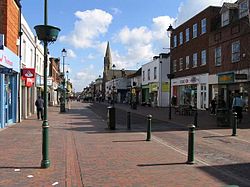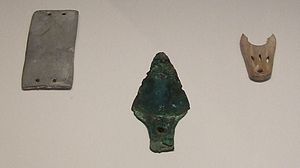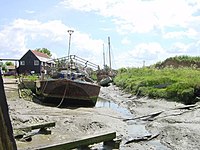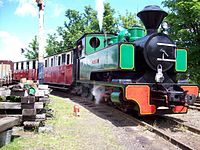Sittingbourne: Difference between revisions
Created page with '{{Infobox town |name=Sittingbourne |county=Kent |os grid ref=TQ905635 |latitude=51.34 |longitude=0.74 |picture=Sittingbourne in 2007.jpg |population=59,000 |post town=Sittingbour…' |
m clean up, typos fixed: an 19th century → an 19th-century |
||
| Line 37: | Line 37: | ||
At this time, the 13th century Parish of St Michael church was constructed, and the High Street contained 13 pubs and hostels. The Lyon - now the Red Lion - played host to King Henry V of England on his way back from the Battle of Agincourt, and Henry VIII visited Sittingbourne in 1522 and 1532.<ref>{{cite web|url=http://www.theredlion-inn.co.uk/history.htm|title=Our History|publisher=The Red Lion, Sittingbourne|accessdate=2010-05-10}}</ref> In 1708 the Rose Inn was built, described by a noted traveller as one of the best in England, where Queen Victoria later stayed overnight.<ref name=roseinn>http://www.sittingbourne-museum.co.uk/OurTown.htm</ref> | At this time, the 13th century Parish of St Michael church was constructed, and the High Street contained 13 pubs and hostels. The Lyon - now the Red Lion - played host to King Henry V of England on his way back from the Battle of Agincourt, and Henry VIII visited Sittingbourne in 1522 and 1532.<ref>{{cite web|url=http://www.theredlion-inn.co.uk/history.htm|title=Our History|publisher=The Red Lion, Sittingbourne|accessdate=2010-05-10}}</ref> In 1708 the Rose Inn was built, described by a noted traveller as one of the best in England, where Queen Victoria later stayed overnight.<ref name=roseinn>http://www.sittingbourne-museum.co.uk/OurTown.htm</ref> | ||
After the railway came in 1858, Sittingbourne became less of a market trading and hostelry stop-off, and more of an 19th century centre of manufacture to fuel the expansion of London, by producing bricks and paper from its clay substrata. | After the railway came in 1858, Sittingbourne became less of a market trading and hostelry stop-off, and more of an 19th-century centre of manufacture to fuel the expansion of London, by producing bricks and paper from its clay substrata. | ||
===The First World War=== | ===The First World War=== | ||
Latest revision as of 21:35, 27 January 2016
| Sittingbourne | |
| Kent | |
|---|---|

| |
| Location | |
| Grid reference: | TQ905635 |
| Location: | 51°20’24"N, 0°44’24"E |
| Data | |
| Population: | 59,000 |
| Post town: | Sittingbourne |
| Postcode: | ME9, ME10 |
| Dialling code: | 01795 |
| Local Government | |
| Council: | Swale |
| Parliamentary constituency: |
Sittingbourne and Sheppey |
Sittingbourne is an industrial town in Kent, about eight miles east of Gillingham, beside the Roman Watling Street, The town is growing rapidly due to a number of large residential developments, and its train line links to London Victoria and “High Speed 1” to St Pancras International, an hour from Sittingbourne railway station.
The town is off a creek in the Swale, the channel separating the Isle of Sheppey from mainland Kent, which gives the town its name.
Name of the town
Hasted writing in the 1790s in his History of Kent states that:[1]
| “ | Sittingbourne was anciently written Sedingbourne, in Saxon, Saedingburga, i.e. the hamlet by the bourne or small stream. | ” |
(It might not bear quite this translation, but the creek is clearly the bourn, or in Old English burna, in the town's name.)
The Kent Hundred Rolls of 1274-5, preserved in the National Archives, record Sittingbourne as Sydingeburn in the following entries:
Item dicunt quod Johannes Maresescall de Synele tenet unam parvam purpresturam in villa de Sydingeburn et solvit domino regi per annum 1d et dominus rex nichil perdit et quod Petrus de London tenet unam parvam purpresturam in villa de Sydingeburn et solvit inde per annum domino regi 1d et rex nichil perdit.
Translated as, Then they say John Marshall de Synele holds one small encroachment in the vill of Sittingbourne and he pays the lord king 1d. each year and the lord king loses nothing and that Peter of London holds one small encroachment in the vill of Sittingbourne and he pays 1d. each year to the lord king and the king loses nothing. [2]
History

The Romans shot straight through - the great route known as Watling Street goes through the town – and nearby Milton Regis became a port and centre of settlement.[3]
Sittingbourne was not recorded as a manor in the Domesday Book of 1086, merely a note attached to Milton with a population of 309. However, after the murder of the Archbishop of Canterbury, Thomas Becket in 1170, pilgrims began to make the journey to Canterbury Cathedral and Sittingbourne became a useful hostelry for many travellers. Sittingbourne is mentioned as a stopping point in The Canterbury Tales, with the Summoner in the Wife of Bath's Prologue says:
| “ | But if I telle tales two or thre / Of freres er I come to Sidyngborne / That I shal make thyn herte for to morne | ” |
At this time, the 13th century Parish of St Michael church was constructed, and the High Street contained 13 pubs and hostels. The Lyon - now the Red Lion - played host to King Henry V of England on his way back from the Battle of Agincourt, and Henry VIII visited Sittingbourne in 1522 and 1532.[4] In 1708 the Rose Inn was built, described by a noted traveller as one of the best in England, where Queen Victoria later stayed overnight.[5]
After the railway came in 1858, Sittingbourne became less of a market trading and hostelry stop-off, and more of an 19th-century centre of manufacture to fuel the expansion of London, by producing bricks and paper from its clay substrata.
The First World War
The area around Sittingbourne was subject to constant air raids by Zeppelins and aeroplanes during the First World War. The Germans used the town as a reference point for bearings on the way to London.
The first visit by a German aeroplane happened on Christmas Day 1914. Guns at Sheerness fired at the lone invader but still one shell dropped into a field at Iwade. The next event was to occur on 16 January 1915 when another solitary pilot from a German aerodrome in Belgium bombed Sittingbourne. This aircraft, a Taube, was pursued by two local airmen, but managed to escape after dropping a couple of bombs.
About 100 air raid warnings were sounded in Sittingbourne during the First World War and anti-aircraft batteries were strengthened in 1917. The last big raid to pass over the town on Whit Sunday (19 May 1918), carried out by a number of Gothas, eliciting perhaps the most ferocious barrage from the ground defences the town had ever seen. The local newspaper, the East Kent Gazette, reported:
"The first of these duels occurred about an hour after the raid had been in progress, and probably this machine was caught while on its way to London. It was engaged by a daring aviation officer while at a great height. The British airman attacked his opponent so fiercely that the German was forced down to a lower height, and ultimately, to the joy of the onlookers, the Gotha burst into flames, seemed to break in two and came down piecemeal, all aflame. The wrecked machine and the three occupants fell by a farm. Two of the Germans fell into marshy ground and their bodies were deeply embedded in the mud. The third man's head struck a wall and was shattered like an eggshell. All three bodies were removed to a local aviation establishment. The fall of the burning Gotha was seen for miles around."
The second Gotha was surrounded by British fighters shortly after, returning from a successful raid on London.
Brickmaking
The local clay was suitable for making bricks, and North Kent is geologically rich in chalk, which is not found in many other places in Europe in such abundance. This led to the development associated industries: water transport, paper, and cement; all of which continue today in the area.
Brickmaking continued in the town well into the nineteenth century. The bricks for the 3.45-mile London Bridge – Greenwich Railway Viaduct were all made at Sittingbourne and transported to the site by barge.[6]
Paper mills and brickfields were fed by barges that brought sand, mud and household waste such as cinders for brick making, and took the finished bricks away on the return journey.
Bargebuilding and seagoing

Barges were needed to move bricks and many other raw materials and finished goods into the Thames and to London and beyond. Sittingbourne was ideally suited for this purpose and a successful barge-building industry developed at Milton Creek.
Sittingbourne developed into a port during the industrial revolution, from which Kentish produce was transported to the London markets. During this era over 500 types of barges are believed to have been built, centred around Conyer, a hamlet of the village of Teynham, found at the head of a small creek between Sittingbourne and Faversham.[7]
After Second World War, these activities began to fall into a decline, so that only the Burley yard continued with the repair of barges until about 1965. Charles Burley (was a brick maker and barge owner). He occupied the yard in Crown Quay Lane. Now occupied by a builders' merchant.[8] This lack of barge repairs led the creek to become silted and derelict. In 1968, the site was owned by Bourncrete Limited, manufacturers of concrete wares. The yard was then leased to the newly established Dolphin Sailing Barge Museum Trust.[7]
The inlet alongside the Museum usually contains at least one vessel brought to the yard for restoration, including the famous sailing barge Cambria.[9]
The town's links with water transport survive today, through a bronze statue of a bargeman in the town centre.
The Dolphin Sailing Barge Museum was destroyed by arson in 2008[10][11] and it be rebuilt in Whitstable Harbour [12]
Paper
Paper manufacture started in Sittingbourne in 1708, when Peter Archer was recorded as a Paper Maker. Sittingbourne Mill existed from circa 1769, which by 1820 had grown and was owned by Edward Smith. The Daily Chronicle owner Edward Lloyd bought the site in 1863. Using pulped straw from the local farmers and esparto (imported from Algeria and Southern Spain) as a replacement for expensive cotton rag which was becoming more expensive; the output supplied newsprint his mills in Bow.[13]
To speed output, in 1904 Lloyd built a wharf on the tidal inlet at Milton Creek, and a horse-drawn tramway to carry materials to the mill. On what is now known as the Sittingbourne & Kemsley Light Railway, in 1906 the first of three steam locomotives, Premier, came into service, all 0-4-2 Brazil type tank engines sourced from Kerr Stuart. In 1913 the railway was extended to the new dock built at Ridham. In 1912, Sittingbourne Paper Mill was the largest producer of newsprint in the world,[13] with its 1,200 employees using 17 machines to make over 2000 tonnes per week, supplying the demands of Fleet Street.
In 1924, Lloyd's son built a new factory at Kemsley, together with a model village for employees. He died in 1936, when the Lloyd group was taken over by Sir William Berry, who in 1936 formed the Bowater-Lloyd Group.[13] After both plants were acquired by Metsa Serla in 1998, the decision was made to close the Sittingbourne Mill in October 2006, with the last reel produced on the 23rd January, 2007.[13]
Economy
Sittingbourne and its consumed suburb of Milton today is a thriving town, with much recent expansion by way of house-building in the former chalk and brick clay works digs. Expansion is powered greatly by the fact that London is just one hour away by train.
Paper manufacture at Kemsley Paper Mill is still the areas largest employer. Much of the surrounding Kentish countryside is good farming land, and being so far south, many varieties of fruit are grown nearby. This part of Kent is particularly famous for apples and cherries. Fruit preserving and packing are hence large employers, while new industrial and retail parks provide additional employment and services.
Transport
Transport has always played a large part of Sittingbourne's history, geographically located midway between the major port of Dover and the important capital of London was the reason for an enlarged settlement at Sittingbourne.
Roads came early to Sittingbourne, with the Roman construction of Watling Street. The equally straight A2 main road and M2 motorway now follow a similar route, and provide access to the town. The A249 passes the town on the west, heading between Maidstone and Sheerness.
Sittingbourne and Kemsley Light Railway

The Sittingbourne and Kemsley Light Railway was built as a paper mill railway, the Bowater Light Railway, though that use ceased by 1969 when it became uneconomic for the works to run it. In that year the system was handed over to the Locomotive Club of Great Britain to be preserved and operated as the Sittingbourne and Kemsley Light Railway. It has since become a significant feature in the town's tourist industry, and provides the only method of transport to the annual Sittingbourne Beer Festival.
The railway, often under threat of closure, may continue under the new owners of Sittingbourne Mill, Essential Land, who have stated that they wanted to keep the light railway for "the future of the history of Sittingbourne".
Media
- Newspapers: The Sittingbourne Messenger
Sport
- Football:
- Sittingbourne FC (nicknamed "The Brickies")
- Woodstock Sports FC (nicknamed "The Sports")
- Motorcycle speedway
Outside links
| ("Wikimedia Commons" has material about Sittingbourne) |
References
- ↑ "Origns of name Sittingbourne". Sittingbourne Heritage Museum. http://www.sittingbourne-museum.co.uk/Name%20Sittingbourne.htm. Retrieved 2010-05-08.
- ↑ (Kent Hundred Rolls Project, Kent Archaeological Society, 2007) http://www.kentarchaeology.ac/khrp/hrproject.pdf
- ↑ "The Romans in Sittingbourne". Sittingbourne Heritage Museum. http://www.sittingbourne-museum.co.uk/Romans.htm. Retrieved 2010-05-08.
- ↑ "Our History". The Red Lion, Sittingbourne. http://www.theredlion-inn.co.uk/history.htm. Retrieved 2010-05-10.
- ↑ http://www.sittingbourne-museum.co.uk/OurTown.htm
- ↑ Turner, J.T. Howard (1977). The London Brighton and South Coast Railway: Part 1. Origins and formation. Batsford. p. 41. ISBN 071340725-X.
- ↑ 7.0 7.1 "Dolphin Yard and Milton Creek". Thamesbarge.org.uk. http://www.thamesbarge.org.uk/barges/charter/dolphinmilton.html. Retrieved 2011-10-06.
- ↑ http://www.sittingbourne-museum.co.uk/studygroup.htm
- ↑ "The famous Sailing Barge Cambria". Thamesbarge.org.uk. http://www.thamesbarge.org.uk/barges/charter/cambriadetails.html#done. Retrieved 2011-10-06.
- ↑ "Sailing Barge Museum suspected arson attack". Msep.org.uk. http://www.msep.org.uk/news-article.php?news_id=17. Retrieved 2011-10-06.
- ↑ Jarrett, Ian (2008-10-27). "Sittingbourne sailing barge museum destroyed in blaze". This is Kent. http://www.thisiskent.co.uk/Sittingbourne-museum-destroyed-blaze/story-12009968-detail/story.html. Retrieved 2011-10-06.
- ↑ "Barge museum on the horizon". Whitstable People. http://www.whitstablepeople.co.uk/news/Barge-museum-horizon/story-10090983-detail/story.html. Retrieved 2011-10-06.
- ↑ 13.0 13.1 13.2 13.3 "Sittingburne Mill - History". Sittingbourne Mill. http://sittingbournemill.co.uk/sittingbournemill/history.php. Retrieved 2010-05-08.
- D. L. Sattin: Barge building and barge builders of the Swale, 1990.
- Alan Major: Hidden Kent, 1994
